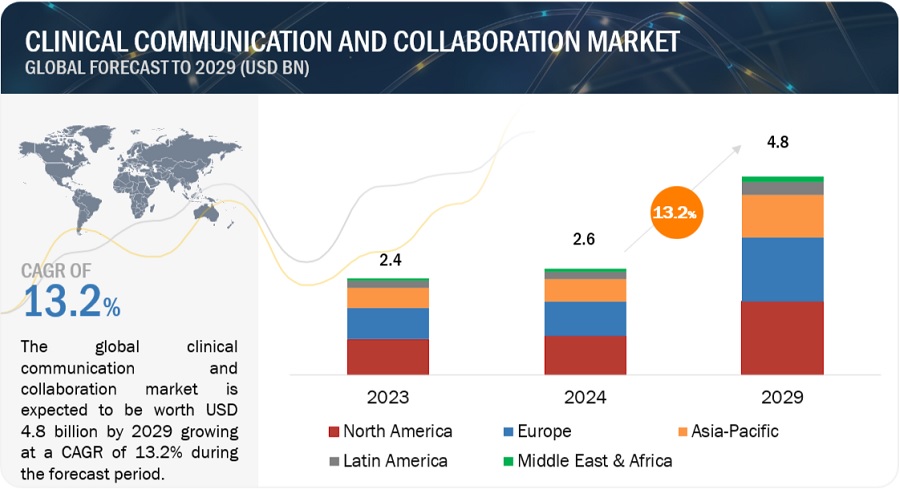The global clinical communication and collaboration market is projected to grow significantly from $2.6 billion in 2024 to $4.8 billion by 2029, representing a compound annual growth rate (CAGR) of 13.2% over the forecast period. This in-depth analysis explores the market’s key drivers, challenges, and opportunities, as well as emerging trends and the competitive landscape.

Market Dynamics
Drivers: The primary factors propelling market growth include the critical role of clinical communication solutions in enhancing patient care and safety, a growing demand for cost-effective healthcare solutions, an increasing geriatric population, and the rising adoption of big data and mobile health (mHealth) tools.
Restraints: However, the high cost of building the necessary IT infrastructure poses a significant barrier. Healthcare organizations must invest heavily in secure messaging systems, video communication, real-time data sharing, and system maintenance, which can be prohibitive, particularly for smaller facilities.
Opportunities: The expanding use of Electronic Health Records (EHR) presents a notable opportunity. As healthcare providers increasingly rely on EHR systems, the need for integrated communication and collaboration solutions becomes more critical. Technological advancements, such as mobile apps and cloud computing, further enhance these opportunities, allowing for greater efficiency and coordination in patient care.
Challenges: Data security remains a major challenge, with healthcare organizations needing to protect sensitive patient information while enabling effective communication among care teams. High-profile data breaches have highlighted the risks, potentially deterring the adoption of new technologies.
Market Segmentation
The clinical communication and collaboration market is segmented by platform, component, deployment mode, application, end user, and region.
Component: In 2023, the software segment, which includes clinical alerting systems, telehealth platforms, and collaborative care platforms, held the largest market share. The growing adoption of digital solutions in healthcare is driving demand for software that streamlines communication and improves collaboration among healthcare professionals.
Deployment Mode: Cloud-based solutions are the fastest-growing segment, offering advantages such as scalability, flexibility, and cost-effectiveness. These systems allow healthcare professionals to access communication tools from any location, facilitating remote and real-time monitoring.
End Users: Hospitals and clinics dominated the end-user segment in 2023. These facilities increasingly rely on clinical communication solutions to centralize communication channels, integrate with EHR systems, and improve patient outcomes through coordinated care.
Geographical Insights: North America held the largest market share in 2023, driven by advanced healthcare infrastructure and high adoption rates of new technologies. The Asia-Pacific region is expected to experience the highest growth, supported by a rapidly expanding healthcare sector, government initiatives, and increased investments in digital health.
Competitive Landscape
Key players in the market include Avaya LLC, Oracle, Cisco Systems, Microsoft Corporation, Baxter International (Hillrom), symplr, NEC Corporation, Spok Inc., Vocera Communications (Stryker), Ascom Holding AG, Everbridge, Hidden Brains InfoTech, and Imprivata, Inc., among others.
Recent Developments
- Microsoft Corporation (US) partnered with Mercy (US) in September 2023 to leverage generative AI for improving patient care.
- TeleVox (US) collaborated with Oracle (US) in August 2023 to enhance patient engagement solutions, utilizing Oracle Cloud Infrastructure.
- Mobile Heartbeat (US) partnered with Akkadian Labs, LLC (US) in April 2023 to enhance communication and collaboration capabilities in healthcare.
Conclusion
The clinical communication and collaboration market is poised for significant growth, driven by the need for improved patient care and the increasing adoption of advanced healthcare technologies. Despite challenges such as high infrastructure costs and data security concerns, the market offers substantial opportunities, particularly in emerging regions and with the integration of EHR systems.
Content Source:
https://www.marketsandmarkets.com/PressReleases/clinical-communication-collaboration.asp
https://www.marketsandmarkets.com/ResearchInsight/clinical-communication-collaboration-market.asp
